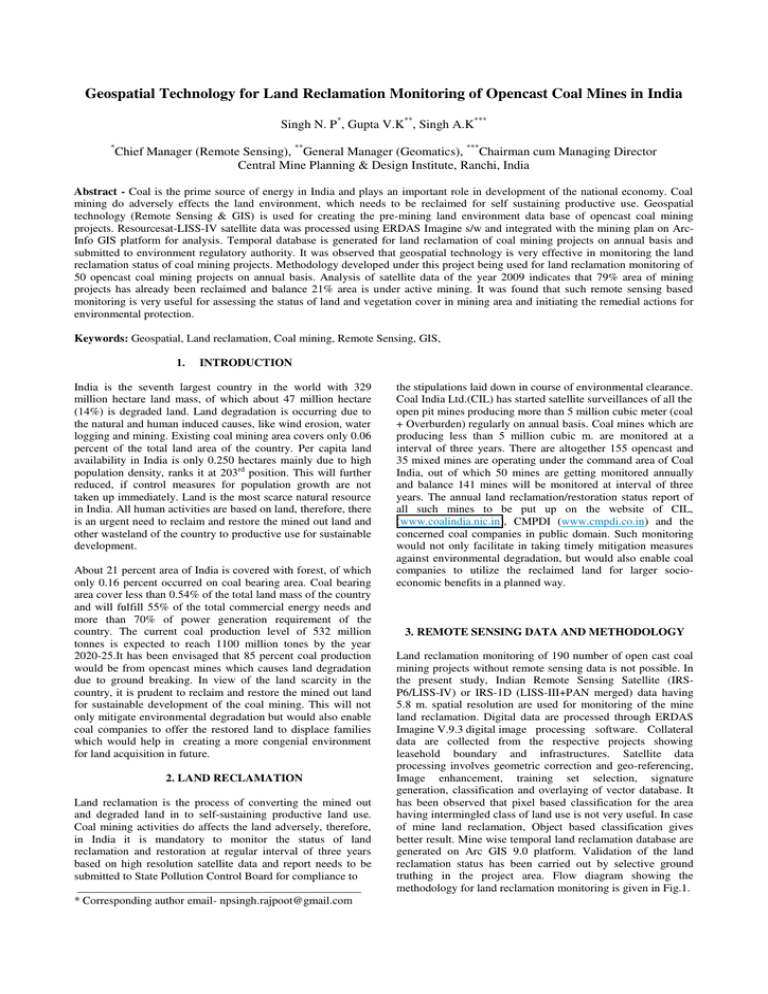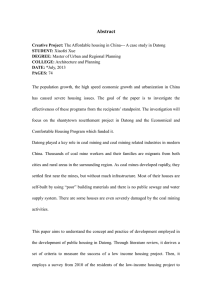Geospatial Technology for Land Reclamation Monitoring of Opencast Coal Mines...
advertisement

Geospatial Technology for Land Reclamation Monitoring of Opencast Coal Mines in India Singh N. P*, Gupta V.K**, Singh A.K*** * Chief Manager (Remote Sensing), **General Manager (Geomatics), ***Chairman cum Managing Director Central Mine Planning & Design Institute, Ranchi, India Abstract - Coal is the prime source of energy in India and plays an important role in development of the national economy. Coal mining do adversely effects the land environment, which needs to be reclaimed for self sustaining productive use. Geospatial technology (Remote Sensing & GIS) is used for creating the pre-mining land environment data base of opencast coal mining projects. Resourcesat-LISS-IV satellite data was processed using ERDAS Imagine s/w and integrated with the mining plan on ArcInfo GIS platform for analysis. Temporal database is generated for land reclamation of coal mining projects on annual basis and submitted to environment regulatory authority. It was observed that geospatial technology is very effective in monitoring the land reclamation status of coal mining projects. Methodology developed under this project being used for land reclamation monitoring of 50 opencast coal mining projects on annual basis. Analysis of satellite data of the year 2009 indicates that 79% area of mining projects has already been reclaimed and balance 21% area is under active mining. It was found that such remote sensing based monitoring is very useful for assessing the status of land and vegetation cover in mining area and initiating the remedial actions for environmental protection. Keywords: Geospatial, Land reclamation, Coal mining, Remote Sensing, GIS, 1. INTRODUCTION India is the seventh largest country in the world with 329 million hectare land mass, of which about 47 million hectare (14%) is degraded land. Land degradation is occurring due to the natural and human induced causes, like wind erosion, water logging and mining. Existing coal mining area covers only 0.06 percent of the total land area of the country. Per capita land availability in India is only 0.250 hectares mainly due to high population density, ranks it at 203rd position. This will further reduced, if control measures for population growth are not taken up immediately. Land is the most scarce natural resource in India. All human activities are based on land, therefore, there is an urgent need to reclaim and restore the mined out land and other wasteland of the country to productive use for sustainable development. About 21 percent area of India is covered with forest, of which only 0.16 percent occurred on coal bearing area. Coal bearing area cover less than 0.54% of the total land mass of the country and will fulfill 55% of the total commercial energy needs and more than 70% of power generation requirement of the country. The current coal production level of 532 million tonnes is expected to reach 1100 million tones by the year 2020-25.It has been envisaged that 85 percent coal production would be from opencast mines which causes land degradation due to ground breaking. In view of the land scarcity in the country, it is prudent to reclaim and restore the mined out land for sustainable development of the coal mining. This will not only mitigate environmental degradation but would also enable coal companies to offer the restored land to displace families which would help in creating a more congenial environment for land acquisition in future. 2. LAND RECLAMATION Land reclamation is the process of converting the mined out and degraded land in to self-sustaining productive land use. Coal mining activities do affects the land adversely, therefore, in India it is mandatory to monitor the status of land reclamation and restoration at regular interval of three years based on high resolution satellite data and report needs to be submitted to State Pollution Control Board for compliance to _________________________________________________ * Corresponding author email- npsingh.rajpoot@gmail.com the stipulations laid down in course of environmental clearance. Coal India Ltd.(CIL) has started satellite surveillances of all the open pit mines producing more than 5 million cubic meter (coal + Overburden) regularly on annual basis. Coal mines which are producing less than 5 million cubic m. are monitored at a interval of three years. There are altogether 155 opencast and 35 mixed mines are operating under the command area of Coal India, out of which 50 mines are getting monitored annually and balance 141 mines will be monitored at interval of three years. The annual land reclamation/restoration status report of all such mines to be put up on the website of CIL, (www.coalindia.nic.in), CMPDI (www.cmpdi.co.in) and the concerned coal companies in public domain. Such monitoring would not only facilitate in taking timely mitigation measures against environmental degradation, but would also enable coal companies to utilize the reclaimed land for larger socioeconomic benefits in a planned way. 3. REMOTE SENSING DATA AND METHODOLOGY Land reclamation monitoring of 190 number of open cast coal mining projects without remote sensing data is not possible. In the present study, Indian Remote Sensing Satellite (IRSP6/LISS-IV) or IRS-1D (LISS-III+PAN merged) data having 5.8 m. spatial resolution are used for monitoring of the mine land reclamation. Digital data are processed through ERDAS Imagine V.9.3 digital image processing software. Collateral data are collected from the respective projects showing leasehold boundary and infrastructures. Satellite data processing involves geometric correction and geo-referencing, Image enhancement, training set selection, signature generation, classification and overlaying of vector database. It has been observed that pixel based classification for the area having intermingled class of land use is not very useful. In case of mine land reclamation, Object based classification gives better result. Mine wise temporal land reclamation database are generated on Arc GIS 9.0 platform. Validation of the land reclamation status has been carried out by selective ground truthing in the project area. Flow diagram showing the methodology for land reclamation monitoring is given in Fig.1. Increased from 191.83 Km2 (Year-2008) to 224.81 Km2 (year2009). This increase of 32.98 Km2 area of land reclamation in one year is result of the efforts made by the coal companies towards land reclamation and environmental protection in mining area. Area of green cover has also increased from 128.06 Km2 (Year-2008) to 149.07 Km2 (year 2009) in 50 opencast projects analyzed under present study. Year wise comparison of land reclamation is shown in fig.3. Further, status of vegetation cover in the coalfield and impact of coal mining on land environment is also being monitored based on satellite data for all the major coalfields of the country at interval of three years. Satellite data of Singrauli Coalfield indicates that area of overall vegetation cover has increased from 175.23 Km2 (Yr. 2000) to 178.94 Km2 (Yr. 2008). Similarly, in Talcher Coalfield, vegetation cover has increased from 443.62 Km2 (Year 1998) to 450.67 Km2 (Year 2003) in span of five years. In Ib Valley Coalfield area of vegetation cover has also increased from 677.39 Km2 (Yr. 1998) to 683.50 Km2 (Yr. 2003). This increase in vegetation cover is the result of massive plantation carried out by the coal companies for environmental protection. In course of the study, wasteland patches area also demarcated for compensatory afforestation. This increase of green cover in coal mining area clearly proves the endeavors of Coal India towards “Green Mining”. REFERENCES (1) Blundell, J.S. and Opitz, D.W., 2006. “Object Recognition and Feature Extraction from Imagery: The Feature Analyst® Approach.” OBIA 2006 – 1st International Conference on Object-based Image Analysis, Salzburg University, Austria, July 4-5, 2006 ISPRS Volume No. XXXVI – 4/C42 ISN 16821777 (2) Crippen, R. E. “Calculating the Vegetation Index Faster, Remote Sensing of Environment,” vol 34, 71-73, (1990). (3) Jha, A.K., Singh, J.S., 1992. Influence of microsites on redevelopment of vegetation on coal mine spoils in a dry tropical environment. J. Environ. Manage. 36, 95-116. (4) Parks, N.F., Petersen, G.W., and Baumer, G.M. “High Resolution Remote Sensing of Spatially and Spectrally Complex Coal Surface Mines of Central Pennsylvania: A Comparison Between Simulated SPOT, MSS and Landsat-5 Thematic Mapper,” Photogrammetric Engineering and Remote Sensing, 53(4), 415-420, (1987). (5)Raman Kumar Dutta, Madhoolika Agrawal, 2003. Restoration of opencast coal mine spoil by planting exotic tree species: a case study in dry tropical region. Ecological Engineering 21, 143-151. 5. CONCLUSIONS Satellite surveillance for land reclamation and restoration monitoring for all the opencast coal mines of Coal India Ltd. using remote sensing data and GIS has been taken up by Central Mine Planning and Design Institute on annual basis. Monitoring for the year 2008 and 2009 has been completed. Project wise temporal data base for each project has been created on GIS platform for analysis. Study indicates that till the year 2009, about 79% mined out area has been reclaimed, out of which 52.39% area is planted and 26.61% area is backfilled and technically reclaimed. Balance 21% area is under active mining. On comparing the status of land reclamation with respect to the year 2008, it was found that area of land reclamation has increased from 191.83 Km2 to 224.81 Km2. This increase of 32.98 Km2 area of land reclamation in one year is the result of the efforts of coal producing companies towards land reclamation. Such monitoring helps in assessing the area of backfilled, plantation, active mining area, water bodies and distribution of wasteland, agricultural land and forest in the leasehold area of the project. Such study will help in assessing the progressive status of mined land reclamation and to take up remedial measures, if any, required for environmental protection. ACKNOWLEDGEMENTS Authors are grateful to the Chairman, Coal India Ltd. for his keen interest in the satellite surveillance of the opencast coal mines for land reclamation monitoring. Our sincere thanks to the Director (Technical) Coal India Ltd. for his guidance and encouragements. (6) Singhroy, V., 2000. Remote sensing for monitoring the effects of mining in Sudbury, Canada, Remote Sensing for Site Characterization, Springer, Berlin, pp. 106-113. (7) Z. Miao, R. Marrs. 2000. Ecological restoration and land reclamation in open-cast mines in Shanxi Province, China. Journal of Environmental Management. 59: 205-215.



